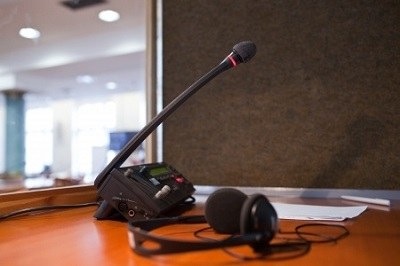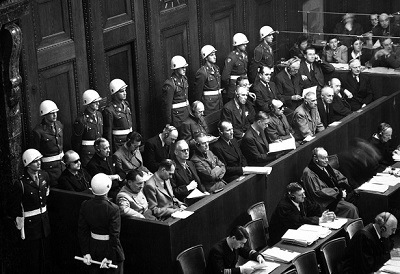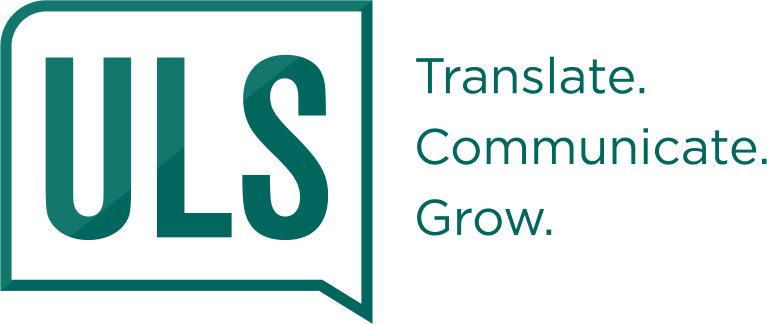Chinese Interpreter, London
We have a highly qualified team of Chinese interpreters. Interpreting refers to the translation of signed language or spoken words into a target language for the purpose of facilitating live communication between two or more people.
At Universal Language Solutions, our highly experienced Chinese interpreters facilitate communication with the verbal rendition of languages for meetings, conferences, court hearings, HR reviews, formal assessments, training sessions, film shoots and many other scenarios. We also supply and install the necessary equipment including sound insulated booths, sound consoles, microphones and headsets.

There are different types of interpretation of which Simultaneous Interpreting and Consecutive Interpretation are the most common ones. While simultaneous interpreters translate the spoken messages almost instantaneously, as the speaker is speaking, consecutive interpreters translate the messages as and when the speaker pauses to allow interpretation.
Up until the end of World War II, consecutive interpreting was the preferred mode of interpretation. Nuremberg war trials of 1945 are regarded as the first large scale international usage of simultaneous interpreting in several languages. But what led to the successful entry of simultaneous interpretation in the international landscape were three events of huge international importance. First, the founding of the United Nations in 1945, second, the establishment of North Atlantic Treaty Organization (NATO) in 1949, and third, the establishment of the European Coal and Steel Community in 1952.

As United Nations had allowed discussions to happen in five official languages which were, Chinese, French, English, Russian and Spanish, simultaneous interpretation during such meetings had become a necessity. However it was the rapid expansion of European communities, which held almost 9000 meetings every year in 9 languages, that helped propagate and sky rocket the need of armies of simultaneous interpreters. Further due to technological advancements such as the widespread use of televisions, where seconds counted and additional time needed for consecutive interpreting was disliked, simultaneous interpreting further advanced and gained importance.
Simultaneous Interpreting
Simultaneous interpretation allows communication of speech from one language to another in real time. It allows multi lingual presentations and conversations to flow naturally and without delay. Listeners of simultaneously interpreted speech generally use wireless audio receivers to hear the translated speech. This unique advantage of simultaneous interpreting over consecutive interpreting has helped fuel its dramatic gitemth in all spheres of interpretation, including multilingual conferences of international organizations or during multilingual meetings between businessmen, scientists and professionals.
For conferences and larger meetings.
- Delegates are provided with headsets and microphones so that their contributions can be transmitted to the interpreting team who often work from soundproof booths situated nearby – their spoken interpretation is then instantly broadcast back to the appropriate delegates. Universal Language Solutions can provide the entire set-up including the interpreting booths, microphones, consoles and engineers.
- Industry standard best practice for simultaneous interpreting is to work with teams of at least two interpreters per language. Interpreters work for alternating thirty minute periods. When not interpreting the resting interpreter remains in the booth to prepare for the next speech and help the other interpreter if required.
- This is skilled and specialist work and experienced conference interpreters are in high demand so advanced booking is advisable. High levels of education, training and preparation are a prerequisite for this type of assignment.
Consecutive Interpreting
In consecutive interpreting, the interpreter is given sufficient time to analyze the context of the source speech. This additional time aided along with the consecutive interpreters memory and special interpreting notes, consecutive interpreters facilitate far more detailed translation. Thus consecutive interpreting is required in meetings of foreign ministries and large corporation, where accuracy is of crucial importance. For example, consecutive conference interpreting was extensively used during arms control negotiations between the United States and the former Soviet Union, which also led to the SALT and START treaties. The reason why consecutive conference interpreting was used during these meetings was because of the grave importance of details which if lost during the course of interpretation, could have meant losses amounting to billions of dollars and loss of lives as well.

For meetings and presentations with a small audience.
- Appropriate scenarios for consecutive interpreting are presentations, press conferences, speeches, court hearings, public inquiries, conference calls and interviews.
- The interpreter often takes notes while a participant speaks, and an interpretation is then given after the speaker has finished, or during appropriate pauses during the speech.
- No specialist technical equipment is required
Whispering Interpreting

Whispered interpreting is a form of simultaneous interpreting in which the interpreter sits in the conference room, next to the delegate or delegates, who need the interpreting or translations. Whispered interpreter first listens to the speech and then interprets the speech simultaneously and whisper it into the ears of delegate or delegates. Whispered interpreting can only be used for very few delegates sitting or standing together and is often used in bilateral meetings.
Whispering interpreting or ‘chuchotage’ is used when one or two people do not understand the source language.
- The interpreter is seated next to the meeting participants and simultaneously renders the interpretation in a low voice.
- No technical equipment is required.
Liaison or bilateral interpreting
Consecutive interpreting requires collaboration between the speaker and the consecutive interpreter. It begins with the interpreter listening to few minutes of a speech segment, taking notes and then delivering that segment into the target language. Once the first segment is complete, speaker resumes and completes the second segment after which the whole process is repeated, right until the end of the speech.
For small business meetings.
- Interpreting is undertaken on a one to one basis where the interpreter will interpret both ways and enable effective communication between two languages and two or more parties.
BEST CHINESE INTERPRETING SOLUTIONS, LONDON
Universal Language Solutions is the best Chinese Interpreting company in London. We are specialist Chinese Interpreting Service providers.
London is the capital and largest city of England and the United Kingdom. London has been a major settlement for two millennia. The City of London, London’s ancient core and financial centre − an area of just 1.12 square miles and colloquially known as the Square Mile − retains boundaries that closely follow its medieval limits. London exerts a considerable impact upon the arts, commerce, education, entertainment, fashion, finance, healthcare, media, professional services, research and development, tourism and transportation.
The main metropolitan of London includes Bromley, Croydon, Ealing, Harrow, Hounslow, Ilford, Kingston, Romford, Shepherd’s Bush, Stratford, Sutton, Uxbridge and Wood Green. List of boroughs includes Barking and Dagenham, Barnet, Bexley, Brent, Bromley, Camden, Croydon, Ealing, Enfield, Greenwich, Hackney, Hammersmith and Fulham, Haringey, Harrow, Havering, Hillingdon, Hounslow, Islington, Kensington and Chelsea, Kingston upon Thames, Lambeth, Lewisham, Merton, Newham, Redbridge, Richmond upon Thames, Southwark, Sutton, Tower Hamlets, Waltham Forest, Wandsworth and Westminster.
CHINESE LANGUAGE
Chinese languages consist of hundreds of local language varieties or dialects which are spoken in Mainland China, Hong Kong, Macau, Taiwan, Southeast Asia (including Malaysia, Singapore) and other areas with historic immigration from China. All Chinese languages are classified into seven to ten groups, of these the largest groups are Mandarin Chinese, Wu, Min and the Yue Chinese. They all belong to the Sino-Tibetan family of languages. Standard Chinese or Standard Mandarin is the official language of China, Taiwan and Singapore.
HISTORY OF INTERPRETING
Interpreting of oral translations has existed since early times. Some studies hint that it even existed in ancient Egypt. But we know from documented sources that interpreting services were used extensively during exploration and invasion campaigns. For example, it was used by Spaniards when they arrived in Central and South America.
WHAT IS INTERPRETING?
Interpretation is oral translation of oral communication, as opposed to sight translation, which is oral translation of written texts. Few specialized fields in professional interpreting are business interpreting, court interpreting, community interpreting and signed language interpreting.
HOW INTERPRETING HELPS?
Interpreting services are used to help people, belonging to diverse backgrounds, communicate during activities such as meetings, training, interviews, mediation, court hearings, news conferences, immigration services, social services, private business communication, community legal education or other group situations.
WHO ARE INTERPRETERS?
Interpreters are highly qualified professionals who can fluently speak in at least more than one language and can convert messages accurately and objectively from one language into another. It is the job of the interpreter to convey the information with accuracy. Universal Language Solutions is a leading translation agency in London. Our experienced team of interpreters are highly experienced and knowledgeable in the specific fields for which they perform interpretation, can easily manage the pace of communication between the speaker and listeners and provide essential advice about the cultural differences between the source and target language.
An interpreter should successfully be able to convey the intent and underlying meaning of the speaker. They are highly experienced language experts who can understand, analyze and process the spoken words or messages in sign language, and thereafter translate the message into the target language. Our leading interpreting services London are trusted by a wide range of clients, who come from different backgrounds and cultures.

AS LEADERS IN CHINESE TRANSLATIONS WE SPECIALIZE IN TRANSLATION FOR ALL MAJOR INDUSTRIES, WHICH INCLUDES:
- Automotive
- Business
- E-commerce
- Engineering
- Gaming
- IT Telecommunications
- Legal
- Life Sciences
- Manufacturing
- Media & Entertainment
- Medical
- Oil, Gas & Energy
- Public Sector
- Travel & Tourism
WE PROVIDE EXPERT TRANSLATION SERVICES FOR OVER 200 MAJOR LANGUAGES, WHICH INCLUDES:
- Arabic Translation
- Bulgarian Translation
- Chinese Translation
- Dutch Translation
- Farsi Translation
- German Translation
- Greek Translation
- Italian Translation
- Japanese Translation
- Korean Translation
- Polish Translation
- Portuguese Translation
- Punjabi Translation
- Russian Translation
- Spanish Translation
- Swedish Translation
- Turkish Translation
WE ALSO PROVIDE DUTCH TRANSLATION SERVICES FOR:





